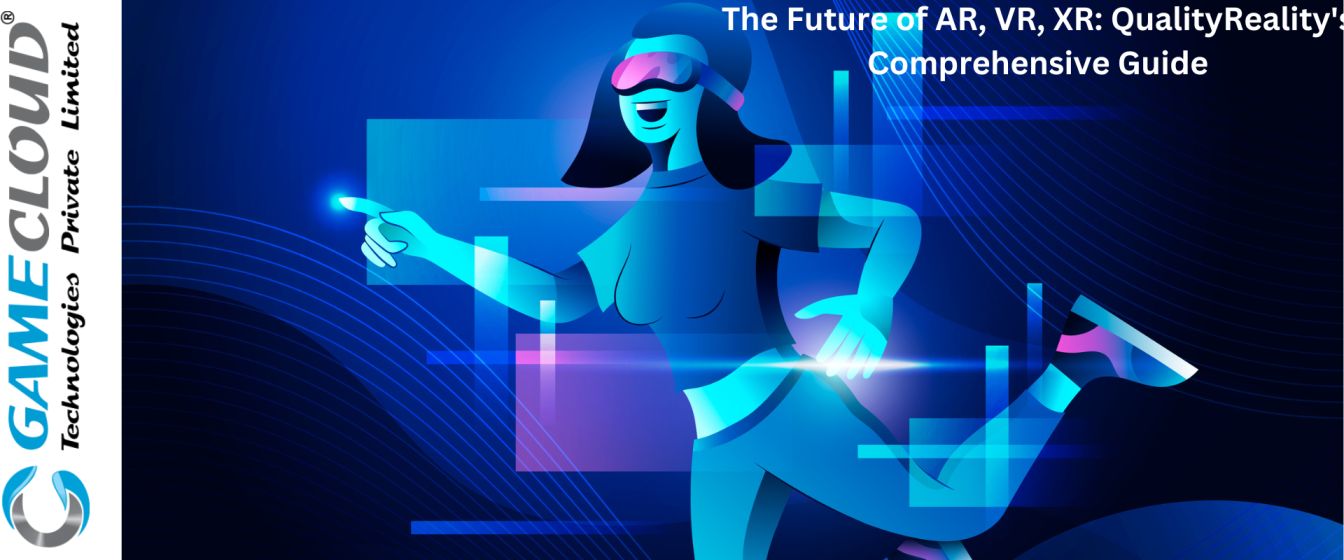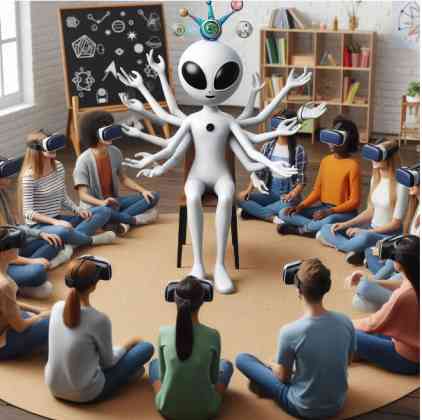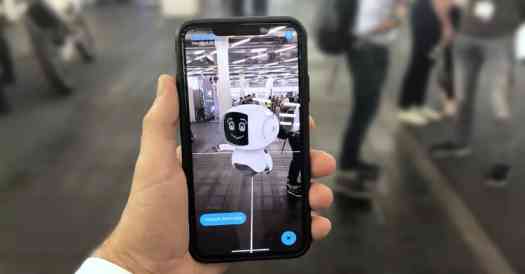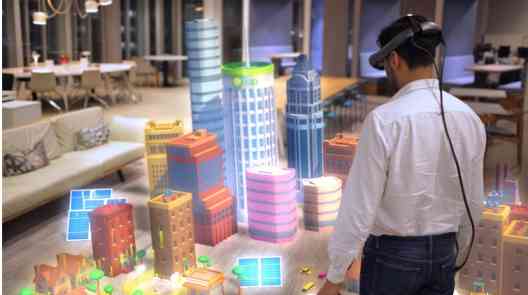
In the realm of game development, the evolution of Extended Reality (XR) technologies has paved the way for innovative experiences and transformative advancements. QualityReality, a sub-brand of GameCloud Technologies Pvt Ltd, has emerged as a pioneering force in the XR and Metaverse Services domain, setting new standards in the industry. This detailed research delves into the intricacies of our contributions and the future landscape of AR, VR, and XR technologies in the context of game development.
QualityReality has been at the forefront of XR solutions since its inception in 2010. Specializing in Extended Reality services, we’re dedicated to pushing the boundaries of immersive experiences in the gaming sector. With a team of experts committed to excellence, we had positioned ourselves as a leader in the XR and Metaverse domain.
Current Landscape of XR Technologies in Game Development
XR Applications in Game Design:
XR technologies have revolutionized game design by offering immersive environments and interactive experiences.
- XR technologies have revolutionized game design by offering immersive environments and interactive experiences.
- QualityReality specializes in providing professional testing services for Metaverse & XR applications, ensuring functional, compatible, and performant apps and games across various platforms.
- Those solutions empower the creation of more amazing game experiences, facilitating collaborative working environments and innovative solutions within the gaming industry.
- Improved user experience in game development is a key focus, with the technologies enabling natural user interfaces, gesture control, speech recognition, and immersive interactions for enhanced gameplay.
- Those technologies have facilitated the rise of hybrid and virtual events, accelerating the adoption of virtual, augmented, and mixed reality experiences across various environments, including the gaming landscape.
- The Metaverse represents a significant opportunity in the gaming industry, offering new gaming community creations, user-generated content platforms, and multiplayer social gaming experiences that redefine the gaming landscape.
QualityReality’s Impact:
QualityReality’s expertise in XR testing and development ensures high-quality, functional, and performant its applications for game developers.
- Our services include a focus on hardware testing for XR technologies, ensuring seamless functionality across a variety of hardware configurations to provide users with a high-quality experience.
- Our mission is to assist developers in delivering top-notch Augmented Reality, Virtual Reality, and Mixed Reality experiences by ensuring apps and games are functional, compatible, and performance across different platforms and hardware setups.
- Our expertise in XR and Metaverse Services positions us as a trusted partner for developers seeking to deliver high-quality XR and Metaverse experiences, with a team of certified QA testers, experienced engineers, and technology reviewers dedicated to ensuring top-tier quality in XR application.
Collaborative Working:
XR bridges the gap between developers and users, enabling seamless collaboration and enhanced user engagement.
- Collaborative working environments are facilitated by XR solutions, empowering the creation of more amazing game experiences and innovative solutions within the gaming industry.
- The Metaverse represents a significant opportunity in the gaming industry, offering new gaming community creations and user-generated content platforms that redefine collaborative working in game development.
- Hybrid and virtual events accelerated by XR technologies have become more prevalent, enabling collaborative working environments and innovative solutions across various industries, including gaming.
- Collaborative working is a key focus in the gaming industry, with these technologies enabling natural user interfaces, gesture control, speech recognition, and immersive interactions for enhanced gameplay and development.

Training and Education:
- XR technologies are revolutionizing the way workforce training and education are approached, offering immersive and engaging experiences that enhance learning outcomes and drive business success.
- Virtual Reality (VR) training provides fully immersive, computer-generated environments for learners to interact with, enabling the development of hard and soft skills in a risk-free and engaging manner.
- Augmented Reality (AR) overlays digital information onto the real world, creating contextual learning experiences that support onboarding, skills training, performance support, and just-in-time information delivery.
- Immersive 360 Video training places learners in a cinematic environment, providing a cost-effective and engaging learning experience that enhances knowledge retention and delivers on learning goals.
Futuristic Trends and Predictions
- Mass Adoption of XR:
- The global XR market is projected to reach $1134.79 billion by 2030, indicating significant growth and potential for widespread adoption of XR technologies.
- XR professionals see more potential for VR and AR technologies in enterprise applications rather than consumer applications, with a focus on XR and AR/MR for enterprise as a high priority over the next 12 months.
- While VR and AR technologies have shown strong growth in enterprise settings, consumer adoption has been slower due to barriers such as the high price of head-mounted devices (HMD), lack of content, HMD size/design, and consumer usability issues.
- Consumer awareness of VR/AR technologies is increasing, with over two-thirds of US adults being aware of VR/AR as a shopping technique, indicating a growing familiarity with immersive technologies among consumers.
- Despite current challenges, XR professionals remain optimistic about mainstream consumer adoption of VR and AR within the next 3-4 years, highlighting the potential for these technologies to become more widely accepted in the near future.
- Enhanced User Experience:
User experience remains a key focus for XR technologies, with advancements aimed at overcoming technical limitations and improving performance.
- Continuously test usability by conducting user testing sessions, gathering feedback, and analyzing user behavior to identify areas for improvement.
- Implement A/B testing to compare different variations of web pages or features, allowing you to make data-driven decisions about which options provide the best user experience.
- Gather user feedback through surveys, polls, and user interviews to understand their pain points, preferences, and suggestions for enhancing the overall experience.
- Analyze user behavior using tools like Google Analytics to track metrics such as bounce rate, time on page, and conversion rates, which can reveal areas where users are struggling or dropping off.
- Make iterative improvements based on the insights gained from testing and feedback, continuously refining and optimizing the user experience over time.
- Regularly review industry best practices and trends to ensure your website or application remains competitive and aligned with user expectations.
- Collaborate with cross-functional teams, including designers, developers, and product managers, to prioritize and implement user experience enhancements effectively.
- AR Navigation:
AR-enabled navigation systems are set to revolutionize location-based services, offering personalized directions based on real-time environmental data.This innovative solution combines real-time positioning with virtual data overlay to provide on-screen directions, making navigation more intuitive and user-friendly.
It operates through a three-stage process: indoor positioning (localization), navigation route planning, and rendering AR objects on top of the real environment. The primary goal is to guide users from point A to point B seamlessly by superimposing digital information onto their physical surroundings, improving spatial awareness and simplifying navigation tasks. These apps leverage technologies like ARKit and ARCore to create immersive and interactive navigation experiences, offering users a more intuitive way to navigate indoor and outdoor spaces.

- XR in Marketing:
XR technologies are reshaping marketing strategies, allowing brands to offer immersive product experiences and detailed analytics for targeted campaigns.
- XR Marketing Overview: XR Marketing involves using Augmented Reality (AR) and Virtual Reality (VR) as tools in the marketing toolkit to reach new customers and impress existing ones.
- AR Marketing: AR Marketing allows products to be virtually placed in customers’ hands or homes, enabling try-before-you-buy experiences without physical contact, reducing costs and enhancing decision-making processes.
- VR Marketing: VR Marketing offers immersive experiences that make products or services seem real, even in the absence of physical interaction, catering to entertainment providers, local services, tour operators, and hospitality providers.
- Future of XR Marketing: XR Marketing is not just a futuristic concept but a practical and innovative tool that businesses can leverage to enhance their marketing strategies and engage customers effectively.
Real-World Examples and Case Studies
- A) Virtual Prototyping in Engineering:
VR technologies enable manufacturers to visualize and fine-tune product designs, reducing development costs and enhancing product quality.
Some key benefits of virtual prototyping in engineering include:
- Reduced time and cost: Virtual prototyping can help reduce the time and cost of new product development by eliminating the need for physical prototypes.
- Improved quality: The ability to quickly explore a wide range of design alternatives leads to improvements in performance and design quality.
- Early testing and performance confirmation: Early availability of physically realistic virtual prototypes allows testing and performance confirmation to take place as design decisions are made, enabling the acceleration of the design activity.
- Linking manufacturing and performance: Virtual prototyping accounts fully for how a product or component is manufactured and assembled, and it links the consequences of those processes to performance.
- B) Immersive Training in Healthcare:
VR is transforming medical training by simulating surgical procedures and providing realistic learning environments for medical professionals.
- Benefits of Immersive Training: Immersive training modules offer self-paced and convenient learning experiences tailored to individual needs.
- Impact of Immersive Training: Immersive training simulations have been proven to enhance skills competency, increase confidence post-training, and improve engagement and retention rates among healthcare professionals and students.
- Future of Immersive Healthcare Training: Immersive training through VR and AR technologies is transforming the landscape of healthcare education, offering hands-on experiences, practical skills development, and enhanced patient care outcomes.
- C) XR in Property Market:
AR applications in the property market offer virtual tours of real estate developments, enhancing customer engagement and decision-making processes.Some applications of XR in the property market include:
- Virtual Tours: XR enables property developers to create highly realistic virtual tours of properties, allowing potential buyers to explore the space without physically visiting the site. This is particularly beneficial during times of restricted travel or when properties are still under construction.
- Augmented Reality Visualizations: AR applications allow buyers to visualize how a property would look like with their own furniture and decor. By overlaying digital content onto the real-world environment, AR helps buyers make more informed decisions and envision themselves living in the space.
- Interactive Brochures and Flyers: QR codes or scannable formats can be added to print materials like brochures and flyers, enabling potential buyers to access additional information and virtual experiences by simply scanning the code. This enhances the traditional marketing materials with interactive and immersive content.
- Global Networking: XR technologies enable property developers to connect with a wider audience of buyers, investors, and sellers across the globe. Virtual events and meetings can be organized, facilitating global networking and expanding the reach of property marketing efforts.

Conclusion
QualityReality’s commitment to excellence in XR and Metaverse services reflects a promising future for AR, VR, and XR technologies in game development. As the industry continues to evolve, our comprehensive guide sets a high standard for immersive experiences, collaborative working environments, and innovative solutions in the gaming sector.
